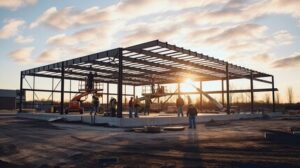Steel Buildings Oklahoma are a modern alternative to traditional construction materials. They combine the design and aesthetic flexibility of a metal building with the structural integrity of concrete.

Frame columns are installed vertically into concrete foundations and connect to eave rafters above. The eave rafters are steel components that hold the roof in place and support wall panels.
As a construction material, steel is incredibly versatile. It’s used in a wide range of building applications, including commercial and industrial facilities. It’s also a popular choice for residential use. There are many misconceptions about steel buildings, but it’s important to separate the truth from the fiction when making decisions for your next project.
The first major point of versatility is the fact that pre-engineered metal buildings can come in a variety of sizes. In fact, some frames can reach up to 480′-which is three times the width of an NFL football field! This means that you don’t have to worry about the length of your new structure being limited by what is available on your property.
Another great aspect of the versatility of steel buildings is that they are able to withstand a variety of weather conditions. This includes earthquakes, lightning strikes, high winds and heavy snowfall. Steel is one of the strongest materials on earth, so it’s no wonder that it can withstand such harsh conditions.
In addition, most steel structures are pest-resistant, meaning that you won’t have to worry about termites or mold growing in your structure. This is a huge benefit that will save you money on maintenance and other related costs.
A lot of people may not consider that steel is a versatile construction material when it comes to visual appearance. However, modern steel buildings are designed with a variety of different architectural styles in mind. They can be both attractive and functional, and they can accentuate the beauty of your property. They’re perfect for those who want a unique building that will stand out from the rest of the neighborhood.
Durability
Steel buildings have a reputation for durability, longevity and resistance to various forms of degradation. This makes them an excellent choice for long-term use, especially in regions with unpredictable weather conditions and natural disasters. However, many people have questions about what specifically contributes to the impressive lifespan of a steel building.
One of the most important factors is the quality of the materials used in a steel building. High-quality, corrosion-resistant steel is available in a variety of thicknesses and lengths to suit any construction project. It is also lightweight compared to other traditional building materials, allowing for longer spans and open-plan spaces.
Another factor is the engineering precision involved in a steel building’s construction. This precision enhances the structural integrity of the building, which in turn helps it to withstand stress and pressure. It also allows for the building to be adapted easily to accommodate changes in needs, which can eliminate the need for premature replacements and contribute to the longevity of the structure.
Durability is further enhanced by the fact that steel buildings don’t contract or expand with moisture content, a major cause of deterioration in concrete structures. They are also pest-resistant, meaning that they can avoid the costly issues associated with termite invasions in wood buildings.
When you take all these factors into account, it’s easy to see why steel buildings have a renowned longevity. They are an excellent choice for commercial, industrial, and residential construction, and can be easily adapted to fit your specific requirements. However, you should always consider the potential limitations of steel buildings in residential use due to local codes and homeowner association rules. If you are interested in investing in a steel building, make sure to consult with a professional who can help you decide whether this option is right for you.
Reliability
In a world of unpredictable weather, it’s important to have a building that can stand up to the elements. Metal buildings are a reliable choice that offer superior performance and durability. They can withstand the harshest of storms and even earthquakes. This is a big reason why many businesses choose to invest in a pre-engineered steel building. This is an economical option that can be used to store equipment, manufacture products, or warehouse goods.
Steel is a ductile material that can bend without breaking and is also extremely resilient against the elements. It is able to endure high winds, thunderstorms, and seasonal changes. Metal buildings can withstand sand storms, heavy snowfall, and powerful rains. They are also fire-proof and highly resistant against lightning strikes.
When it comes to building reliability, there is nothing quite like a steel structure. Unlike wood or other materials, steel can stand up to extreme weather conditions and still look beautiful years after it was built. Additionally, it is less prone to rust and corrosion, which means you can save money on maintenance and repairs.
Another factor that contributes to steel building reliability is their speedy construction process. Compared to traditional wooden structures, steel buildings can be erected in just a few weeks. This is because most of the components are pre-manufactured and are ready to be welded together on site. This makes the entire construction process a lot faster and allows for a quicker occupancy time. Moreover, the simplified design of a pre-engineered metal building reduces the overall cost of the project.
Energy Efficiency
Steel is a strong and durable material that can stand up to almost anything. It’s also very energy efficient when used in a steel building. This means that the building will be able to better control its temperature, keeping it cooler in the summer and warmer in the winter, and saving the owner money on energy costs.
In addition to energy efficiency, steel buildings are environmentally friendly. This is because most of the steel used in construction comes from recycled sources, which reduces the amount of raw materials that need to be mined. It’s also recyclable, so it can be reused for future projects without losing its strength and durability.
Another aspect of the green-friendly nature of steel buildings is that they can be made with more windows, allowing more natural light to enter the building and further cutting down on energy costs. In addition, most steel structures can be fitted with high R-value insulation, making them even more energy efficient.
Lastly, a steel building can withstand most extreme weather conditions. Steel is a resistant material that will not warp or rot like wood, so it can resist the effects of changes in the environment. Additionally, the straight framing often used in steel buildings will prevent sagging over time, which can significantly cut down on energy costs.
All of these features make a steel building an appealing option for anyone looking to build a commercial space. However, it’s important to remember that your building will only be as energy-efficient as the insulation and other components used in it. To ensure your building is energy-efficient, it’s best to work with a team that knows how to use and install metal building components correctly.
Maintenance
It would be nice if a steel building was a hands-off structure that required very little maintenance, but unfortunately this isn’t the case. Rust, mold, and other problems can easily snowball if not caught early on. That’s why it’s important to make routine inspections of your metal storage or garage building.
A few key areas to look for are ground settlement, trees and bushes too close to the building, rodent activity, insulation damage, and water and air leaks. A visual check is the best way to see if there are any issues that should be addressed.
During the inspection, you should also make sure there are no loose screws or connections that need tightening. The natural expansion and contraction of building materials during weather changes can cause loose screws that may let in the elements.
If there are any cracks in the wall or roof, seal them as soon as possible. This will prevent moisture and air from damaging the interior walls and ceilings.
It’s also a good idea to clean the exterior of your steel building every few months. Dirt and grime build up over time, causing abrasions that can cause rust or mold if not addressed. You should also oil the hinges on any doors or windows that open and close frequently to ensure they move smoothly. Finally, check the drainage pipe to ensure it is clear of any blockages or intermediates that could allow water to back up into the building. This can cause water to seep through the walls, causing rust and mold. A drainpipe that is clear can easily be fixed by a plumber, but a blocked one will require a professional to clean and repair it.

